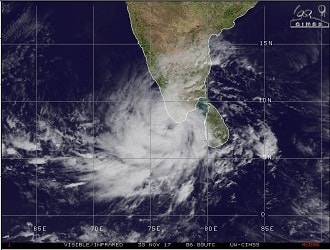
Cyclone Ockhi, predicted to pass over the Lakshwadeep islands and veer away from mainland India will now turn and head towards parts of coastal Maharashtra and South Gujarat.
It was unlikely to cause much havoc as there was not much moisture in the Arabian Sea for the weakening cyclone to draw on.
Recurving cyclones such as these are rare.
The death toll in Kerala due to the cyclone has gone up to nine.
As many as 6007 persons were accommodated in 34 relief camps opened by the district administration in Thiruvananthapuram, Kollam, Alappuzha, Ernakulam, Thrissur and Malappuram.
130 fishermen from Kerala and Tamil Nadu were in safe shelters on four islands - Kalpeni, Kiltan, Chetlat and Agatti - and had received medical aid.
TN, Lakshwadeep and Kerala have been impacted by the cyclone so far.
What is a Recurving Cyclone?- Generally tropical cyclones, known variously as hurricane, typhoons etc., start out moving west then turn toward the pole of their hemsphere and finally end up moving east.
- This pattern is called recurvature.
- The recurvature has something to do with the rotation of the Earth. Local wind and temperature conditions and local topography can influence the path and produce erratic elements to the paths but the general pattern has to have a geophysical explanation.
- That explanation is that a cyclone has two components of angular momenta. One is with respect to its own spin axis and the other is with respect to the spin axis of the Earth. When a body with angular momentum, such as a gyroscope, is subjected to a torque it precesses; i.e., it angular momentum vector rotates.
- If a body with angular momentum is forced to precess then it is subject to a torque. A cyclone rotates with the Earth and its angular momentum vector is kept pointing vertically because of the rising of warm air in its eye (center).
- The resulting torque forces the cyclone toward the pole in its hemisphere.
- But as the cyclone moves toward the pole it gets closer to the spin axis of the Earth.
- The preservation of angular momentum then results in the cyclone moving faster with respect to the pole and hence starts moving east. Its path has thus recurved.